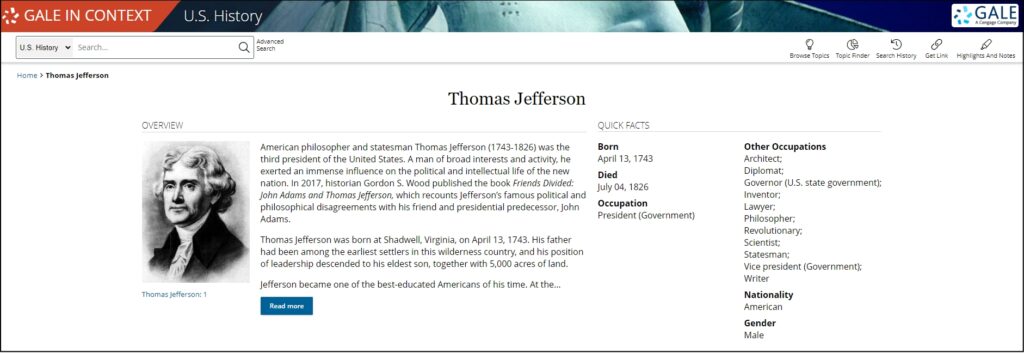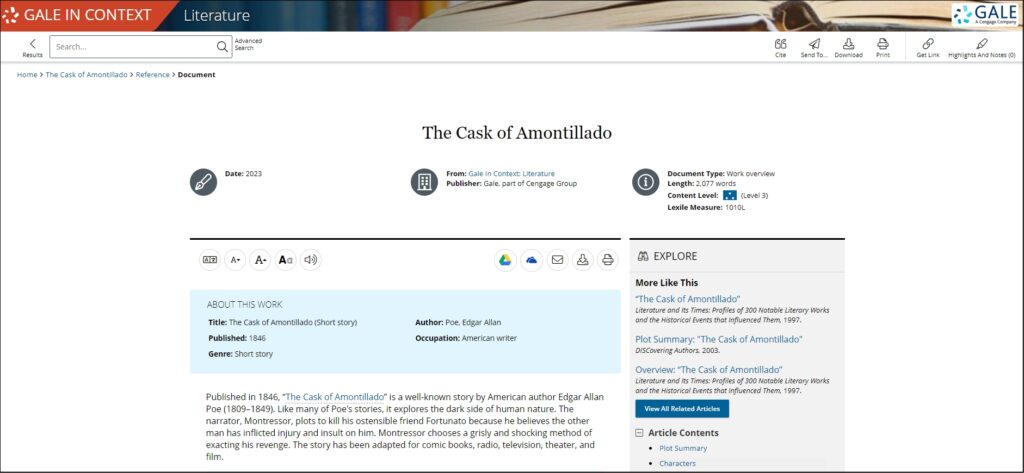| By J. Robert Parks |
Edgar Allan Poe has been a favorite of English and language arts teachers for decades. Many who want to introduce the concept of rhyme schemes have relied on his poem “The Raven,” many who want to introduce the concepts of tone and suspense have presented “The Tell-Tale Heart,” and many who want to introduce symbolism and metaphor have assigned “The Fall of the House of Usher.” Coincidentally, the commemoration of Poe’s death falls during the lead-in to the spooky holiday of Halloween. This week marks the 175th anniversary of Poe’s death, so there’s no better time for educators and librarians to take advantage of the wealth of resources in Gale In Context: Literature and Gale In Context: U.S. History. Everything from literary analysis to literary history to Poe in the context of U.S. history is at your fingertips.
Poe was born on January 19, 1809, but he was soon an orphan. His father abandoned the family, and his mother died of tuberculosis when Poe was three. He was sent to live with John and Frances Allan (this is where Poe got his middle name), who were a wealthy couple in Richmond, Virginia. They made sure he received a good education, and in 1826 he entered the University of Virginia, which had been founded by Thomas Jefferson just seven years prior. Unfortunately, Poe did more than attend classes while he was in Charlottesville. He drank and gambled, both to excess.
Nonetheless, he soon set off for Boston expecting to become a great writer. That didn’t pay the bills, so he joined the army and was surprisingly well suited to being a soldier. He was less well suited to being an officer-in-training, however, and he began drinking again and was kicked out of West Point in 1831.
Poe returned to writing, both poetry and fiction, and he also worked for various literary magazines. He was a sharp critic and is credited with helping advance the American short story through his review of Nathaniel Hawthorne’s collection Twice-Told Tales. Of course, Poe’s own short stories are masters of the genre. Along with such classics as “The Cask of Amontillado” and “The Black Cat,” Poe also pioneered the detective story, inspiring numerous writers including Arthur Conan Doyle.
Arguably, “The Raven” is Poe’s most famous work. The entry notes, it’s “a repetitive poem about repetition,” and it’s a pleasure to recite and has inspired numerous parodies. These homages include such wide-ranging offerings as Henry Beard’s “The End of the Raven” and a segment from a “Treehouse of Horror” episode in The Simpsons.
Gale In Context: Literature and Gale In Context: U.S. History also cover Poe and many of his contemporaries along with discussions of American Romanticism. Entries reflect on how the movement fits into the wider context of U.S. culture. There’s also an interesting article on Poe’s connection to the development of science in nineteenth-century America, and there’s even an entry that argues Poe’s death was caused by election fraud. Well, kind of.
It seems appropriate that Poe’s death would be mysterious. It’s been commonly attributed to alcoholism, but others have suggested he committed suicide or died of syphilis, cholera, or rabies. Speculation on his fate is particularly amplified by his connections to the literary legacy that he left behind. Those looking for a literary angle to highlight for students this Halloween season couldn’t do much better than turn to the master of the macabre himself, Edgar Allan Poe.
About the Author
J. Robert Parks is a former professor and frequent contributor to Gale In Context: U.S. History and Gale In Context: World History who enjoys thinking about how our understanding of history affects and reflects contemporary culture.




